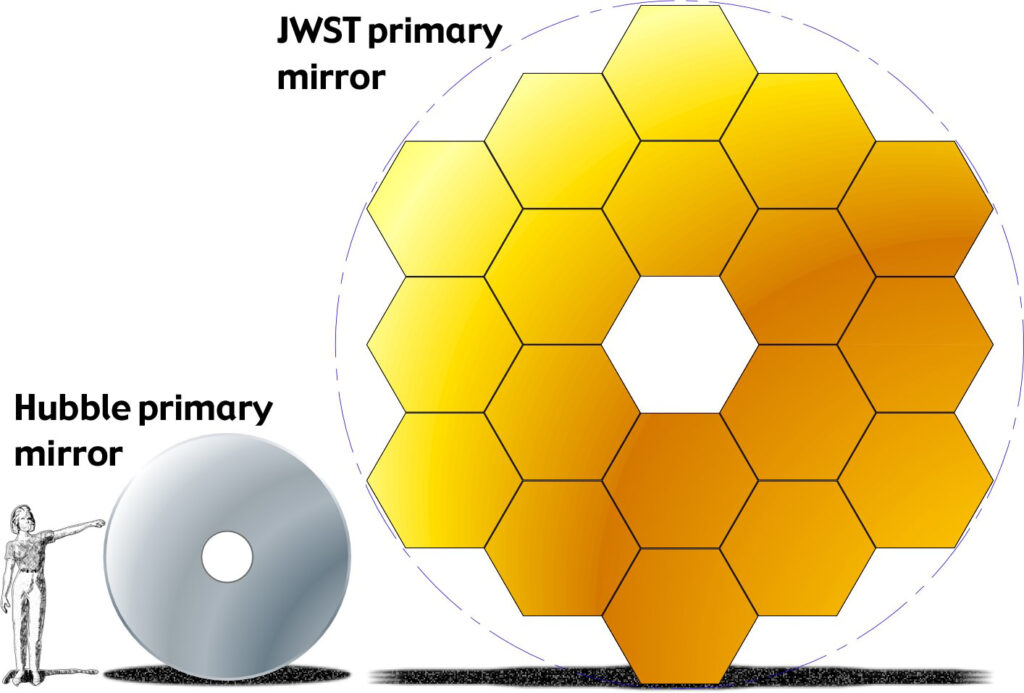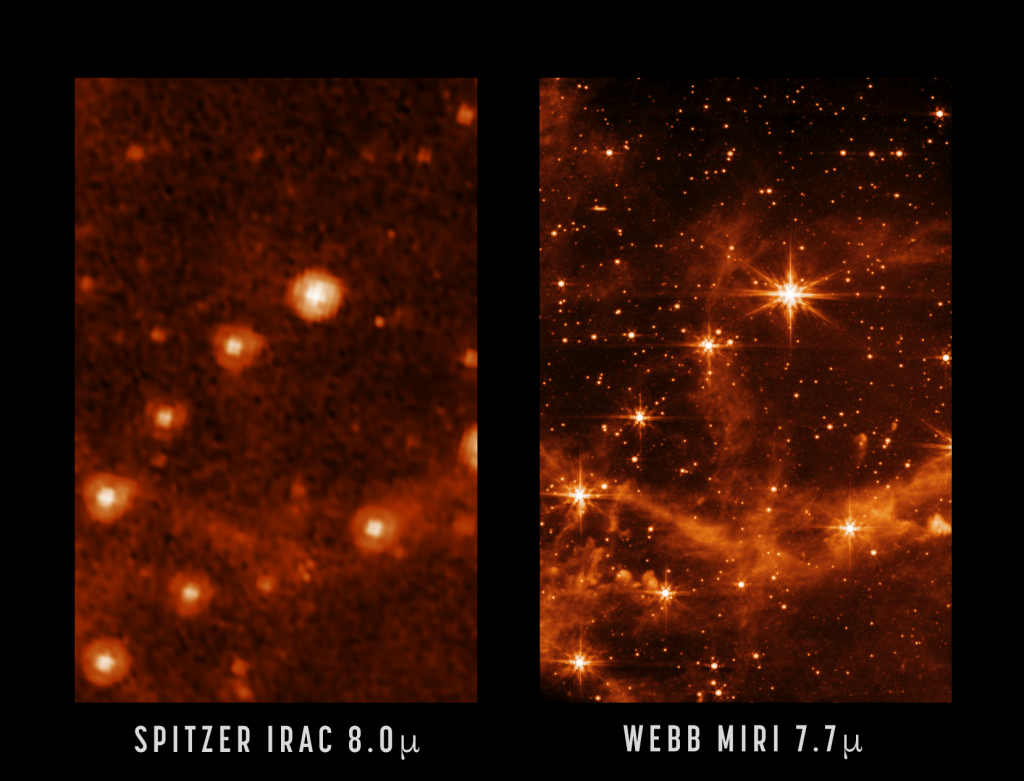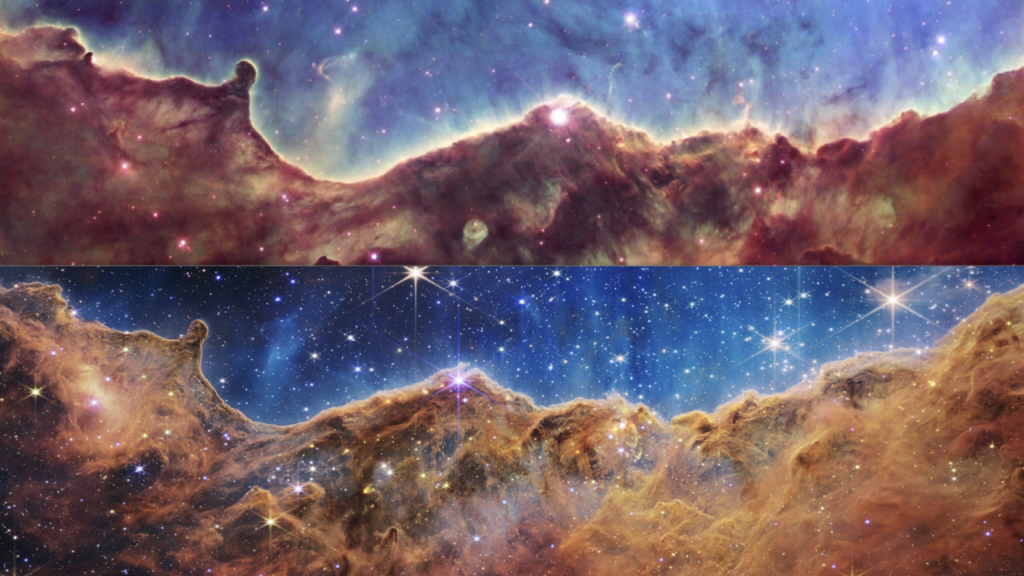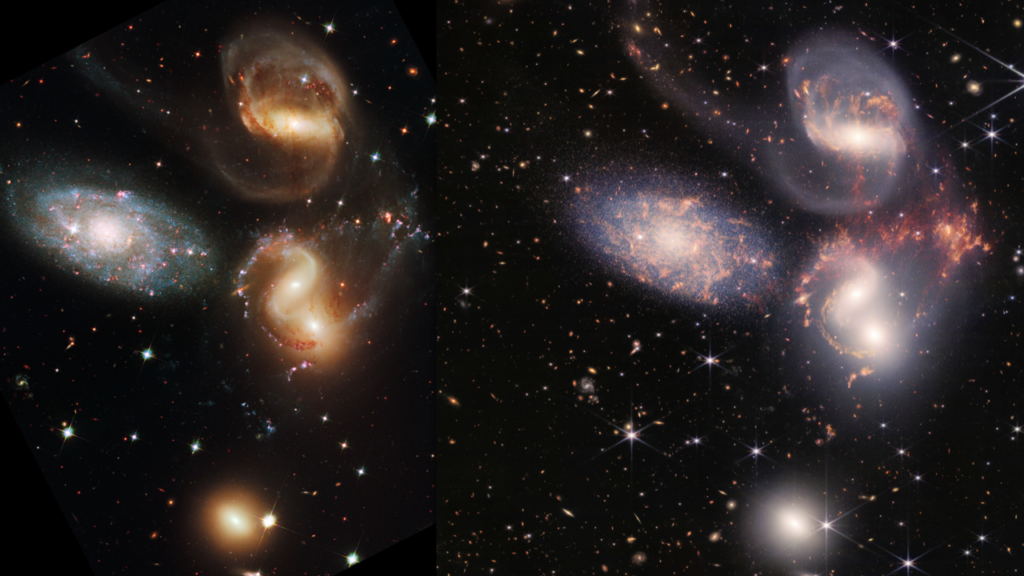James Webb Space Telescope: Initial Revelations
The much-anticipated James Webb Space Telescope (JWST) has delivered its first images and created excitement and even controversy. This project’s scope is large and ambitious; therefore, I think it’s worthwhile to explain some of the steps that have led to where we are, what we know, and what’s ahead. At minimum, the JWST has already provided evidence of the structure and history of the early universe that carries big bang implications.
Building and Transporting the JWST
In August 2021, I got to see the JWST up close during its final stages of assembly at the Northrup Grumman aerospace facility in Redondo Beach, California. The JWST is as tall as a 3-story building and as long as a tennis court. The diameter of its main mirror is 6.5 meters (21 feet). The JWST’s main mirror has more than seven times the light collecting area as the Hubble Space Telescope (HST). Because of amazing design advances, the JWST is only half the weight of the HST. See figure 1.
Unlike the HST, the JWST is designed to detect the infrared part of the electromagnetic spectrum. Hence, it is ideally suited to explore the highly redshifted part of the universe—that part of the universe that reveals the first few billion years of cosmic history.

Credit: Goddard Space Flight Center
In September 2021, the JWST was transported by ship to Kourou, French Guiana, South America, where it was placed on an Ariane 5 rocket ready for launch. On December 25, 2021, it was launched into space. On January 24, 2022, it reached its final destination at the L2 Lagrange point in Earth’s orbit 930,000 miles from Earth. At the L2 Lagrange point, the gravitational pull on the JWST perfectly balances the gravitational pull of the Sun. This balance means that the JWST will not fall out of orbit and that very little of its limited fuel supply will be needed to keep it in a stable fixed position relative to Earth.
Operational Setup and Tests
As with any major research telescope, the JWST’s first few months were devoted to setting up its optics and instruments and testing its operational capabilities. In May 2022, NASA released a side-by-side comparison of a test image taken by JWST’s Mid-Infrared Instrument of a small region of the Large Magellanic Cloud and the best image of the same region taken by the previously most powerful infrared telescope, the Spitzer Space Telescope. See figure 2 for the comparison. This initial test image assured astronomers that the JWST indeed was capable of making spectacular breakthrough astronomical discoveries.

Credit: NASA/JPL-Caltech (left), NASA/ESA/CSA/STScI (right)
Initial Scientific Findings
On July 10–11, NASA released the first five astronomically significant images taken by the JWST. By design, these images were of the same parts of the celestial sky as previous images taken by the HST. The intent was to determine to what degree the JWST was superior to the HST and what new science the JWST could be expected to uncover. The five initial images—the next three below show some physical features of the universe—exceeded astronomers’ expectations.
Carina Nebula: Figure 3 shows a portion of the Carina Nebula showing the best image of that portion taken by the HST side-by-side with the first attempt at imaging that portion by the JWST.

Figure 3: Small Part of the Carina Nebula by the HST (top) and the JWST (bottom)
Credit: NASA/ESA/CSA
The Carina Nebula is a star-forming nebula. Some of its gas and dust clouds are expanding and, thus, pushing against other gas and dust clouds. Other parts of its gas and dust clouds are collapsing. The pockets of collapsing gas and dust clouds that are cold are on their way toward becoming stars. These pockets, known as Bok globules, are found in “elephant trunks,” the long fingers of illuminated gas and dust.
In the HST image, only a few ill-defined elephant trunks and Bok globules can be seen. In the JWST image, several dozen well-defined elephant trunks and Bok globules are clearly seen. This image has already revealed additional details about ongoing star formation.
There are hundreds of star-forming nebulae in the Milky Way Galaxy (MWG) and its companion galaxies in the Local Group. The JWST promises to give us a comprehensive, detailed understanding of the physics and process of star formation that spans stars ranging in mass from 0.08 to 30 times the Sun’s mass.
Stephans Quintet: Four of the five galaxies that make up the tight grouping known as Stephans Quintet are gravitationally connected to one another. The fifth, the bright bluish one to the upper left, is a foreground galaxy. It is 200 million light-years away. The distance of the other four is about 300–400 million light-years from us.
Figure 4 shows HST’s best image of Stephans Quintet on the left and the initial image of Stephans Quintet by the JWST on the right. Visible wavelengths are optimal for showing the distribution and structure of stars and star clusters in galaxies. Infrared wavelengths are optimal for showing the distribution and structure of gas and dust in galaxies. Therefore, analyzing a combination of HST and JWST images of galaxies will yield unprecedented insights into the structure and dynamics of a wide range of different types of galaxies.

Figure 4: Stephans Quintet by the HST (left) and the JWST (right)
Credit: NASA/ESA/CSA
The most obvious difference between the HST and JWST images of Stephans Quintet is what can be seen in the background. The HST image shows only a few distant galaxies. The JWST image reveals hundreds of distant galaxies and at a resolution that identifies what kinds of galaxies they are.
Astronomers were surprised to learn how many of the more distant galaxies are fully developed disk galaxies. However, such galaxies are easier to detect at infrared wavelengths in the distant universe than several other kinds of galaxies. Thus, deeper images by the JWST of many different regions of the celestial sky will be needed to discern the true distribution of galaxy types in the early universe.
Cartwheel Galaxy: Soon after the release of the first five astronomically significant images by the JWST, astronomers used the JWST to image the Cartwheel Galaxy, also known as PGC 2248. Figure 5 shows HST’s best image of the Cartwheel Galaxy on the left and the initial JWST image of the Cartwheel Galaxy on the right.

Figure 5: Cartwheel Galaxy by the HST (top) and the JWST (bottom)
Credit: NASA/ESA/CSA
The Cartwheel Galaxy’s extraordinary structure arose from a major merging event of two large galaxies. The HST image shows hints of a few of the bars of gas and dust that connect the inner part of the galaxy to the giant ring of newly formed stars. The JWST image shows all these bars in exceptional detail.
There are several remaining mysteries about the physics and dynamics of galaxy merger events, which the JWST is poised to solve. These soon-coming solutions will give astronomers a more complete understanding of the history of the universe. For astronomers, such a comprehensive history will produce an even more detailed and precise big bang creation model.
Did the Initial Findings Repudiate the Big Bang Creation Model?
Not everyone is convinced of the JWST’s big bang support. It’s been widely rumored that the initial images from the JWST have repudiated the big bang creation model of the universe. This rumor was sparked in an online article by Eric Lerner, author of the book, The Big Bang Never Happened.1 In this book, Lerner, a committed atheist, claimed that electromagnetism, not gravity, dominates, and has dominated, the dynamics of the universe. Shortly after the book was released, I debated Lerner on the big bang on a radio show. In the fourth edition of The Creator and the Cosmos I cited several measurements establishing that galactic and intergalactic magnetic fields are much, much too weak to sustain any of Lerner’s speculations.2
In Lerner’s online article, he wrote concerning the initial JWST images that “to most professional astronomers and cosmologists, they are also extremely surprising—not at all what was predicted by theory. In the flood of technical astronomical papers published online since July 12, the authors report again and again that the images show surprisingly many galaxies, galaxies that are surprisingly smooth, surprisingly small and surprisingly old. Lots of surprises, and not necessarily pleasant ones. One paper’s title begins with the candid exclamation: “Panic!”3 Lerner concluded, “The hypothesis that the JWST’s images are blatantly and repeatedly contradicting is the Big Bang Hypothesis that the universe began 14 billion years ago in an incredibly hot, dense state and has been expanding ever since.”4
The preprint paper whose title began with the word “Panic!” does not, as Lerner implies, communicate either in the abstract or the paper itself any panic or worry about the big bang creation model.5 The first part of the paper’s title is a pun. It reads “Panic! At the Disks,” which is a pun on the name of a pop band, Panic! at the Disco. The sixteen authors, including Rogier Windhorst, who has endorsed one of my books on the big bang, express confidence that the JWST will deliver a more refined and detailed big bang creation model. That is, they express their belief that the JWST will provide more, not less, evidence for the big bang.
On July 20, 2022, I posted two images on my Facebook page of a galaxy taken by the JWST. Astronomers estimated that the galaxy’s mass was a billion solar masses, that it was compact, and that it was more distant than 13.5 billion light-years. That distance implied that it existed when the universe was less than 300 million years old. Many big bang creation models predict that galaxies that massive and compact should be rare in the early universe. If they prove not to be rare, such a demonstration would be problematic for those big bang creation models. Likewise, the JWST is finding more large, well-formed spiral galaxies in the early universe than what several big bang creation models would predict.
Do these recent JWST discoveries debunk the big bang? Not at all. There are many big bang creation models that predict exactly these discoveries. It’s even possible that the discoveries do not refute any big bang creation models. Billion-solar-mass compact galaxies in the universe may yet prove to be relatively rare. Likewise, large, well-formed spiral galaxies may prove to be relatively less abundant in the early universe than what the initial JWST images show. Such galaxies are the easiest ones to detect in the early universe. Therefore, we shouldn’t be surprised that they show up in the first JWST images of the early universe.
As an example of such early, unexpected discoveries, I’m old enough to remember the discovery of the first quasar, 3C 273. It was so bright and only 2.4 billion light-years away that astronomers first deemed it a problem for several big bang creation models. Such models predicted that quasars like 3C 273 should be rare. Well, six decades later, 3C 273 has indeed proven to be rare. It still ranks as the optically brightest quasar in the sky and one of only a few quasars less than 2.5 billion light-years away.
The JWST’s initial images do show that the most distant galaxies are smaller in size than nearby galaxies. However, this is not a problem for the big bang as Eric Lerner has claimed. It’s what all big bang creation models predict. The farther away astronomers observe, the farther back in time they see, owing to the finite velocity of light. In big bang cosmology, many of the first stars form clusters. These first-formed star clusters merge to form larger star clusters. The larger star clusters merge and pull in gas clouds to form dwarf galaxies. Many of the dwarf galaxies merge to form larger galaxies. Thus, big bang models predict that while dwarf galaxies will remain the most common galaxy type in the universe, the number and sizes of galaxies will tend to increase as the universe ages.
Primary Scientific Missions
The rationale for constructing and launching the JWST was for it to achieve at least six primary scientific missions which, to date, no other telescope could achieve. These six primary missions are:
- To determine how the universe’s first stars form, the relative sizes of the first stars, and the number density of the first stars
- To determine how and when the first galaxies form and what types of galaxies comprise the first galaxies
- To determine in specific detail how, when, and where stars form in the present universe
- To determine the chemical composition of the atmospheres and hydrospheres of exoplanets of various types
- To determine how planetary systems form and evolve
- To search for more carbonaceous molecules in giant molecular clouds that may serve as the “building blocks of the building blocks” of life and to measure the relative abundance of these molecules
Attaining these objectives will yield far more evidence of the structure and history of the universe. That evidence will show which cosmic creation models are correct.
The Heavens Declare the Glory of God
Several places in the Bible tell us that the heavens declare the glory, power, and righteousness of God. During the time of Abraham, Jacob, Moses, and David there was very little light and air pollution. During a clear night, these patriarchs could see 15,000 stars and the full sweep of the MWG.
Today, the majority of humanity lives in large metropolitan cities. In these cities, the light and air pollution is so intense that humans struggle to see stars. Where I live in the Los Angeles Basin, on an exceptionally clear night people struggle to see 30 stars. In many Asian cities, it’s not possible to see even a single star. In fact, one of our Reasons to Believe employees hosted a student from China who asked about the bright object in the sky. Our employee explained that the object was the Moon. In China, the student had only been able to see the Moon when it was directly overhead.
To most people using their naked eyes, the heavens don’t seem to be declaring anything at all. But through space telescopes, they are proclaiming the wonders and beauty of God and his creation to a degree never before seen. We in the twenty-first century are the most privileged—in this respect—of all humans. We’re witnessing in the heavens the existence, attributes, and purposes of God exponentially more explicitly and in more detail than anyone before us has experienced. Thanks to the James Webb Space Telescope, we can look forward to exponentially greater revelation of God’s glory, power, love, and righteousness. Much more than to any other generation, Romans 1:20 and Hebrews 2:3 apply to us.
For since the creation of the world God’s invisible qualities—his eternal power and divine nature—have been clearly seen, being understood from what has been made, so that people are without excuse. —Romans 1:20
How shall we escape if we ignore so great a salvation? This salvation, which was first announced by the Lord, was confirmed to us by those who heard him. —Hebrews 2:3
Check out more from Reasons to Believe @Reasons.org
Endnotes
- Eric J. Lerner, The Big Bang Never Happened: A Startling Refutation of the Dominant Theory of the Origin of the Universe (New York: Random House, 1991).
- Hugh Ross, The Creator and the Cosmos: How the Latest Scientific Discoveries Reveal God, 4th ed. (Covina, CA: RTB Press, 2018), chapter 6.
- Eric J. Lerner, “The Big Bang Didn’t Happen: What do the James Webb Images Really Show?” iai news (August 11, 2022), https://iai.tv/articles/the-big-bang-didnt-happen-auid-2215?_auid=2020.
- Lerner, “The Big Bang Didn’t Happen.”
- Leonardo Ferreira et al., “Panic! At the Disks: First Rest-Frame Optical Observations of Galaxy Structure at z > 3 with JWST in the SMACS 0723 Field,” arXiv:2207.09428, version 2 (July 28, 2022), doi:10.48550/arXiv.2207.09428.





